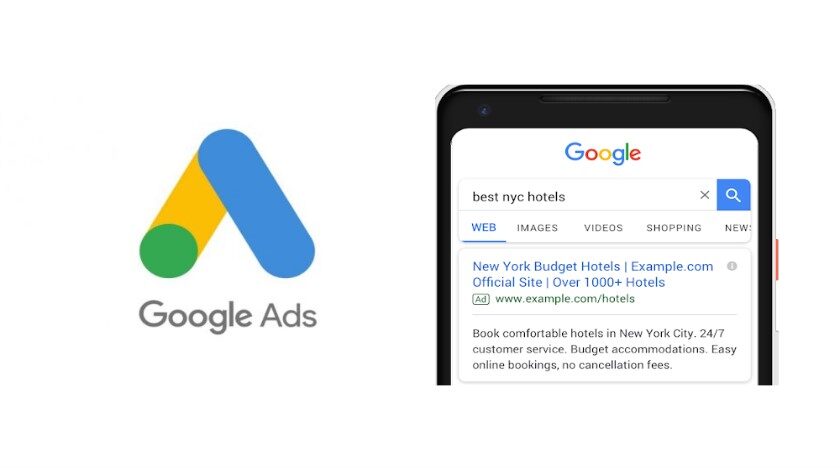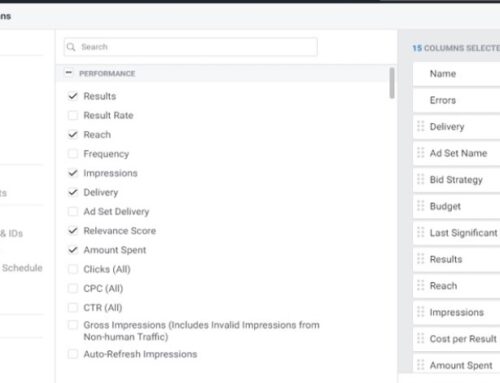How does Google Ads generate responsive search ads?
Responsive search ads, or in short, RSAs, are the newer ad format that was introduced by Google a few years ago. However, they will be the default and only available option after June 2022, as Google plans to remove expanded text ads (ETAs). So, it is no surprise that most advertisers want to know how to make the most use of RSAs. The goal of this article is to help you with this.
Let’s first do a brief overview of what exactly RSAs are—how they look, how they work, and finally, how Google works with them.
What do responsive search ads look like?
In RSAs, you are given a maximum of 15 headlines, 4 descriptions, a display, and a final URL. The main thing here that is unique is the increased number of headlines you can write. This alone puts most advertisers off guard. 4 descriptions are also twice the number you were allowed to use in ETAs (2). Basically, now you have to write a lot more. On the right side, there’s a preview panel that shows you how your ads will look when Google combines them together. You also have an option to swap between mobile and desktop view.
When you click on “more ideas”, Google will give you a list of suggestions you can put in your ads.
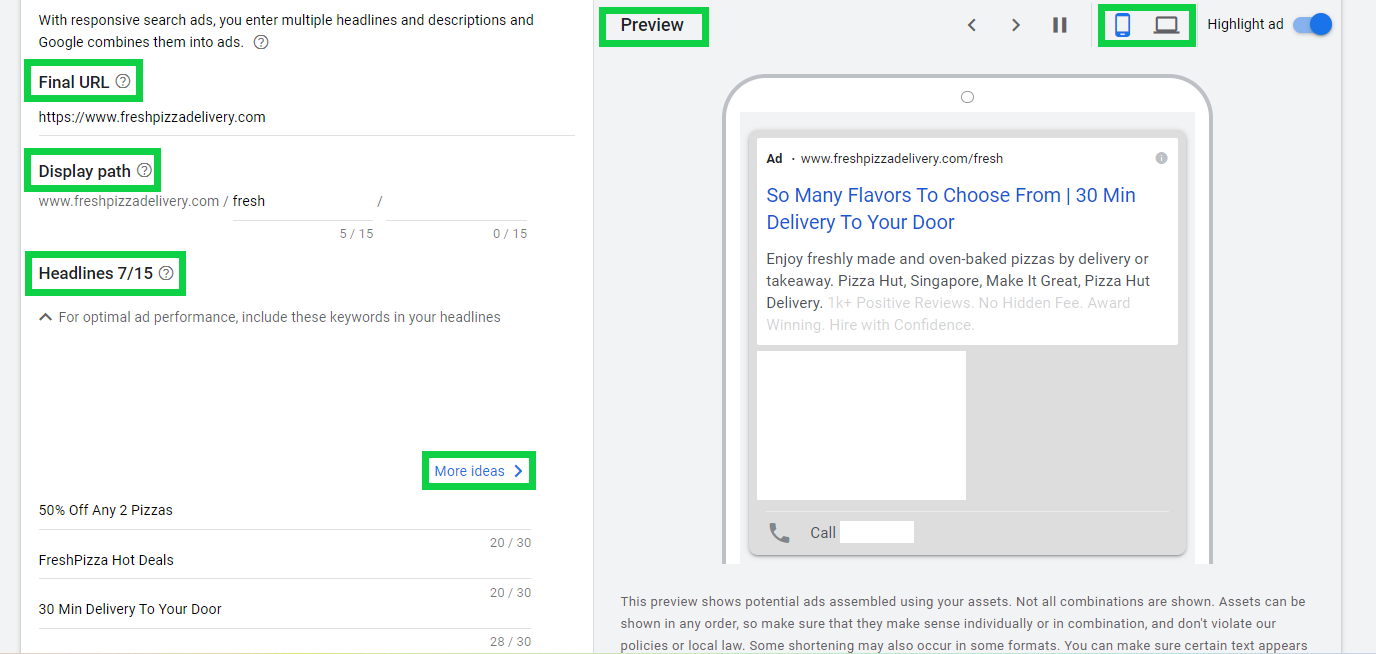
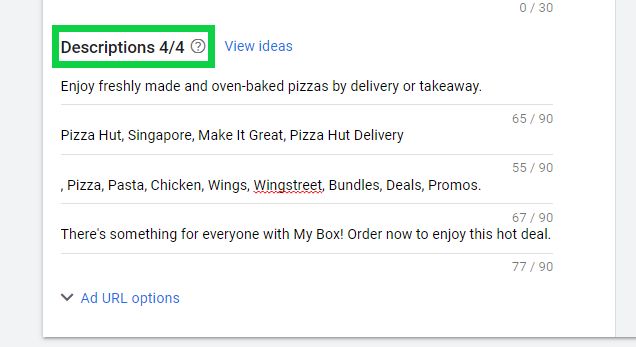
Your RSAs are also rated by a metric called “Ad Strength” and this measures the relevance and diversity of your ad combinations. Aiming for “Excellent” will maximize your chances of success. (In some cases, you will not have “excellent”, especially when running competitor-based ads.)
Ad strength is calculated by 4 main components.
- Add more headlines
- Include popular keywords in your headlines
- Make your headlines more unique
- Make your descriptions more unique

Make sure you try your best to fulfill every criterion above and aim for “Excellent”. Once again, what Google wants are diversity and relevancy. We have always been taught to write relevant ads since the dawn of Google Ads. Customers only click on relevant ads. But as we move into the era of RSAs, Google demands one more thing from advertisers. And that is; diversity.
So remember, when creating RSAs, you must have these 2 words in the front of your mind: diversity and relevancy.
How does Google generate responsive search ads?
Google Ads automatically generates RSAs and tests different combinations to learn which combinations perform best. By adapting your ad’s content to match potential customers’ search terms more closely, responsive search ads may improve your campaign’s performance.
Remember that Google can only generate ads based on what you have put in. So make sure you only use the best assets and continually test. This is an elegant update because not only does it free us of time, it also gives us the ability to run very flexible ads based on what the searcher may be searching in real-time.
Problems with expanded text ads
Expanded Text Ads, or ETAs, are static and were never able to do this. Unless you have 100 ads running in a campaign, most searchers will just see the same ad. We know that 15% of all daily searches were never seen before in Google. Customers are finding your products in ways unimaginable. So RSAs are created to adapt to this ever-evolving digital landscape.
Benefits of responsive search ads
There are so many benefits of RSAs. Let’s examine a few. First, it lets you easily create flexible ads that adapt to different device widths. On desktops, it might show 3 headlines as the space allows. But on mobiles, it may just show 1 or 2. Second, it saves time since you do not have to create dozens of static ads to show to different customers. RSAs take your assets and generate relevant combinations to show to your customers.
Third, because your ads are now more flexible and diverse, it allows you to participate in more ad auctions and searches that Google deems you to have a relevant ad. Lastly, because your ads now compete widely, you can possibly gain more clicks and conversions than before.
Most essential responsive search ads tips
Now that you know how RSAs work and how Google generates them in real-time, let us look at a few highly essential tips that you should know before working on any RSAs.
1. Write a diversity of headlines & descriptions
As mentioned, Google Ads automatically tests different combinations and learns which combinations perform best. You have to write a diversity of ad assets so that their machine learning can find the best combinations available. If all you do is write a benefit in 15 different ways, your RSAs will fail. Use a fresh diversity; aim for uniqueness in your headlines and descriptions. You can include features, benefits, pricing, shipping, inventory, CTAs, awards you won, or any unique selling propositions you have.
The list is endless. Keep generating new ideas that you can possibly use in the headlines and descriptions.
2. Check ad performance after 5,000 monthly impressions
The “Performance” column helps you compare how your assets perform relative to other assets of the same type within your responsive search ad. This will allow you to optimize your responsive search ads by adding or replacing assets based on their performance. This is only available after your search ad has accrued at least 5,000 impressions in any given month.
The performance column is essentially the prime mover when optimizing RSAs. Without it, you really wouldn’t know what to optimize for. Google tells you the result of their tests, which worked and which didn’t. And you need to optimize based on the results. The more data is accumulated, the more accurate the performance column is.
3. Best vs. Good vs. Low
Continuing on the previous point, you will see 3 grades of your assets within the performance column. “Best”, “Good” and “Low”. Google recommends you to replace “Low” performing assets, keep “Good” performing assets, and use “Best” performing assets to help you improve your ads. Say your ad has accumulated 10,000 impressions this month, and Google found that out of all the headlines they tested, the headline “Easy installation as 1-2-3, takes 2 minutes.” was rated “Best”.
However, if Google needs more data before it can grade the asset, it will be labeled as “Learning”.
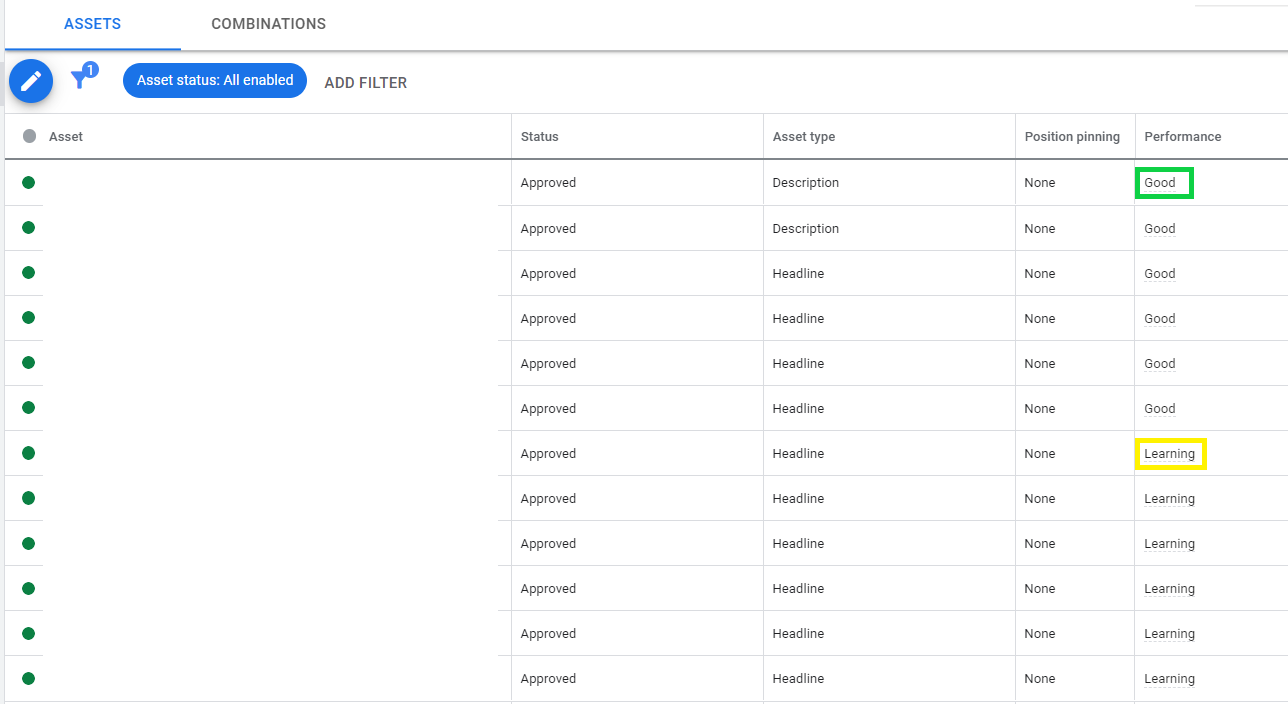
This tells you that your customer is most interested in the convenience of installing your product after they purchased, such as it taking only a few minutes to install. You should then look to further iterate this “advantage” in your future ads. You can also use this data to improve your business landing page by mentioning the convenience of easy installation. Perhaps it’s so simple that no manual book reading is needed. The “Best” rating tells you a lot about not just what works in your ads but what works with your customers. Remember this point.
Next, you should keep “Good” ad assets as Google finds them to perform well. The priority should be to replace the “Low” ad assets. These are underperforming and possibly draining your budget. So get rid of them as quickly as possible and replace them with new ad assets. You can even draw inspiration from the “Best” ones.
4. You can use Ad Customizers
Don’t forget that you can also use ad customizers in your RSAs. They worked in the ETAs and works in RSAs as well. Ad customizers improve your ad relevancy, click-through rates and provide timely information that your customer may want to know.
There are 3 main types of ad customizers you can use. Dynamic keyword insertion, countdown, and location. There is also a 4th tool called “Ad Customizers” where you can fine-tune and control how your ads look based on each searcher with a feed.
5. Counterintuitive – Reduce your assets for faster optimization
This tip is counterintuitive. While everyone recommends you fill up all the available ad spaces, 15 headlines, and 4 descriptions. At times when you need data quickly for faster optimization, you should reduce your assets. Still, keep the diversity, but using fewer assets will help you quickly get a performance rating on each of them. Fill it up entirely if you are willing to wait for a while before optimizing, or you have a bigger budget, which will allow data to be collected at a much faster rate.
6. Test RSAs with multivariate testing
Ad testing can be difficult or harder to execute in RSAs. But it’s not the case. Though A/B testing is not possible with RSAs, multivariate testing will become the new norm. Instead of different headlines like the traditional A/B test, seek to test different themes or subjects. You can have 1 ad using features + benefits. And another testing features + pricing. The main difference between the 2 ads will be benefits vs. pricing. You can also test pinned and unpinned ads.
In the example below, I tested 2 different RSAs and made use of the “Label” dimension to name the test variables.
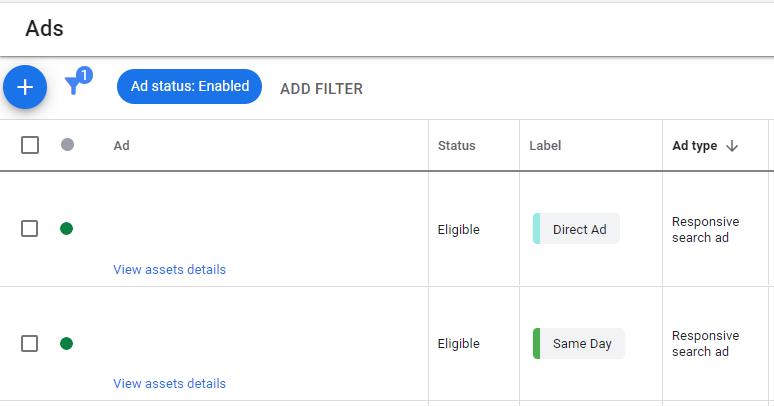
Just make sure you know which variable(s) you are testing, and keep all the rest constant!
Summary
Alright, we have learned that responsive search ads are the new add-ons to search campaigns and are likely the future of how we will create search ads. We also understood how responsive search ads looks, how it works, and most importantly, how Google generates them based on the ad assets you input. Google automatically looks for combinations that are performing well and allows your ads to be flexible to different searches.
This does not mean that your work is done. You still need to go into your account regularly to change out the low-performing assets, understand what works best, and replicate it for further success. Remember to write a diversity of headlines and descriptions, check the “Performance” column after 5,000 monthly impressions, optimize based on the asset’s ratings, use ad customizers to boost your relevancy, reduce assets if you need data quickly, and test RSAs as well.
Good luck with your RSAs!
